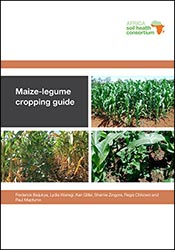
|
The Africa Soil Health Consortium (ASHC) have just released an all-encompassing guide on maize-legume cropping systems with major contributions from N2Africa. The guide aims to provide all the most important information needed to design and implement effective systems which combine maize and legumes, with a primary focus on maize. The overall objective is to provide guidance on how to achieve sustainable increases in yields through the adoption of best practises that exploit the advantages of maize-legumes systems, increasing maize yields from around 0.5-1.2 tonnes per hectare (or even less) to 1.5-6 tonnes per hectare and increasing legume yields from less than 0.5 tonnes per hectare to 1-3 tonnes per hectare. |
The guide showcases options for best practices that are based on the characteristics and requirements of maize and the ‘big five’ legumes - common bean, groundnut, cowpea, soybean and pigeon pea. It starts with simple clear explanations of the underlying principles of intercropping before going on to provide practical guidance. The guide gives a detailed overview of management strategies, as well as potential constraints and how they can be overcome.
Sub-humid climates are most appropriate for maize. However, many farmers try to produce maize in more marginal areas that are sometimes considered to be too dry. This guide therefore provides practical guidance for growing maize-legumes in the sub-humid zones as well as in more challenging environments in Africa.
The guide was compiled by Frederick Baijukya (N2Africa and IITA), Lydia Wairegi (CABI), Ken Giller (N2Africa and WUR), Shamie Zingore (IPNI), Regis Chikowo (N2Africa and University of Zimbabwe) and Paul Mapfumo (University of Zimbabwe), and can be downloaded from the following link: http://africasoilhealth.cabi.org/materials/maize-legume-system-colour-cropping-guide/
